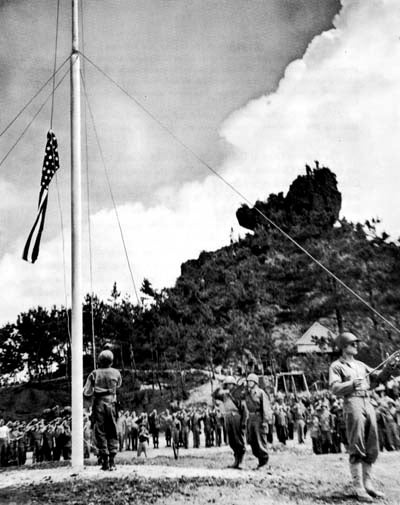Operation Iceberg: The Battle of Okinawa
On April 1st, 1945, the final amphibious landing of the war occurred when the U.S. Tenth Army invaded Okinawa.
Consisting of four U.S. Army divisions, and three U.S. Marine divisions, the U.S. Tenth Army executed Operation ICEBERG to take the island of Okinawa in preparation for the invasion of mainland Japan.
Soldiers and Marines fought for 82 days, finally capturing the island and destroying all resistance on June 22, 1945.

marking the end of organized Japanese resistance.
Photo: U.S. Department of Defense
As they battled the Imperial Japanese Army, they learned of VE Day (Victory in Europe) that occurred on May 8, 1945.

attack against approximately 130,000 defenders. Photo: U.S. Department of Defense
The fighting on Okinawa was some of the fiercest of the Pacific Theater, as the Japanese knew the Americans were on their doorstep and closing in. In fact, the battle has been referred to as the “typhoon of steel” in English, and “tetsu no ame” (“rain of steel”) or “tetsu no bōfū” (“violent wind of steel”) in Japanese. The nicknames refer to the ferocity of the fighting, the intensity of Japanese kamikaze attacks and the sheer numbers of Allied ships and armored vehicles that assaulted the island.
The battle was one of the bloodiest in the Pacific, with approximately 160,000 casualties on both sides; at least 50,000 Allied and 84,166–117,000 Japanese, including drafted Okinawans wearing Japanese uniforms. Approximately 149,425 Okinawans were killed, died by suicide or went missing, which is roughly half of the estimated pre-war population of 300,000. Two U.S. Army Generals were killed on the island during the campaign. Twenty-four Congressional Medal of Honors were awarded.

Photo: U.S. Department of Defense
Airborne Connection
The U.S. Army’s 11th Airborne Division, The Angels, moved to Okinawa and prepared to land at Atsugi Airdrome near Tokyo, on August 30, 1945.
They cleared and occupied the area around Yokohama to receive General Douglas MacArthur, and to begin Occupation Duty of Japan. Prior to this, The Angels were near Lipa, Luzon in May 1945 to rest, refit, and begin training for Operation OLYMPIC, the invasion of mainland Japan. The surrender of Japan cancelled the operation.

Photo: U.S. National Archives Catalog
Did you enjoy this content? If so, please consider giving a gift to the ASOM so we can continue our mission of telling the history of Airborne and Special Operations units.



